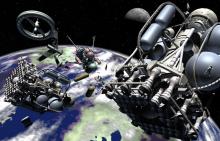Space debris
A car-sized object thought to be space junk
Authorities were investigating on July 18 whether a cylindrical object about the size of a small car that washed up on a remote Australian beach is space junk from a foreign rocket.
Police had cordoned off the barnacle-encrusted object after it was discovered at Green Head about 250 kilometers north of the city of Perth late on July 16.
- Read more about A car-sized object thought to be space junk
- Log in to post comments
EU Prepares Mission to Clean Space Garbage
Every space mission launched from Earth often leaves the remains of the spacecraft still floating in space. This could endanger the next mission to space or even fall to Earth as happened to Chinese-made rockets some time ago.
- Read more about EU Prepares Mission to Clean Space Garbage
- Log in to post comments
Remnants of Chinese Rocket Landed in Indian Ocean
Remnants of China's biggest rocket landed in the Indian Ocean on Sunday, with most of its components destroyed upon re-entry into the atmosphere, ending days of speculation over where the debris would hit but drawing U.S. criticism over lack of transparency.
- Read more about Remnants of Chinese Rocket Landed in Indian Ocean
- Log in to post comments
Chunks of Chinese Rocket Threaten to Fall to Earth
Debris from a Chinese rocket threatens to fall to Earth in the next few days after it was used to launch the core module of China's new space station.
Space experts warned of an "uncontrolled" re-entry of the 20-ton main section of the launch vehicle into the Earth's atmosphere.
- Read more about Chunks of Chinese Rocket Threaten to Fall to Earth
- Log in to post comments
SpaceX launches 60 more satellites, trying to tone them down
SpaceX launched 60 more mini internet satellites late on Jan. 6, this time testing a dark coating to appease stargazers.
It's a "first step" compromise between SpaceX and astronomers fearful of having dark skies spoiled by hundreds and, eventually, thousands of bright satellites circling overhead.
Space Debris Is a Problem for Satellites
Space satellites are increasingly required to maneuver to avoid possible collisions and damage with increasing amounts of space debris, according to DPA, citing astronaut and European Space Agency (ESA) coordinator Thomas Reiter.
The situation has worsened significantly in recent decades and is not expected to change in the future, Reiter notes.
- Read more about Space Debris Is a Problem for Satellites
- Log in to post comments
Mission Shakti, India’s Anti-Satellite Missile test conducted on 27 March, 2019
Polish Companies Ready to Join the Space Race and Clean Up Earth's Orbit
While countries and organisations around the world continue to compete to conquer space, Poland has taken the lead in a slightly different sphere: cleaning the skies of space debris, reported Emerging-Europe.
Satellite Net Developed in the UK Collects Space Junk for the First Time
Debris orbiting the Earth at more than 17,000 mph has been snared by a prototype "junk hunting" satellite for the first time.
The experimental RemoveDebris satellite first released the metal object and then fired a five metre wide net to capture it from a distance of six metres.
Spacecraft Cemetery: The oceanic dumping ground where spaceships go to die (VIDEOS-PHOTOS)
As ships, stations, and other satellites come crashing down to Earth, many end up making planet-fall at the same spot in the Pacific Ocean just south of New Zealand. For years these downed science vessels have simply sunk down to the bottom of the sea in a place now known as the Spacecraft Cemetery.










